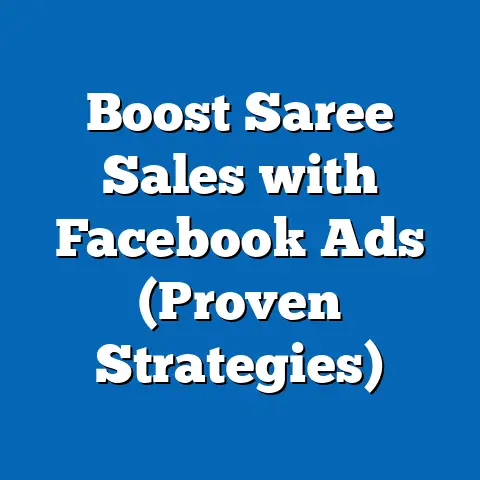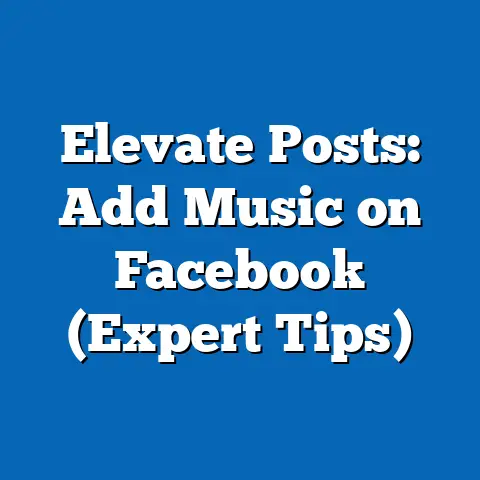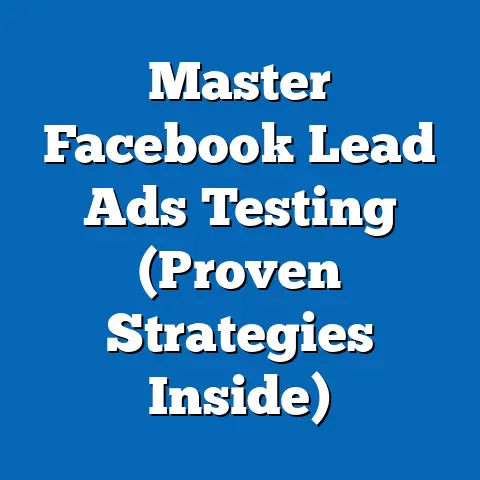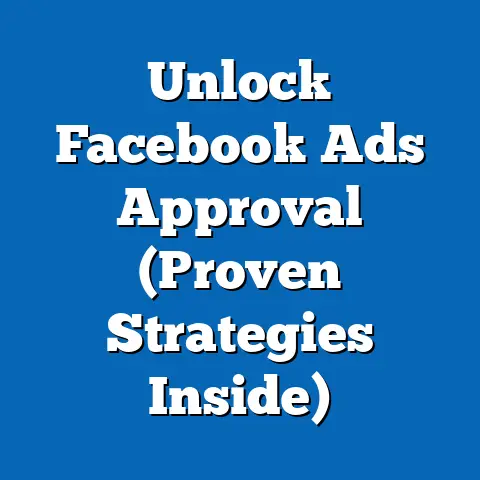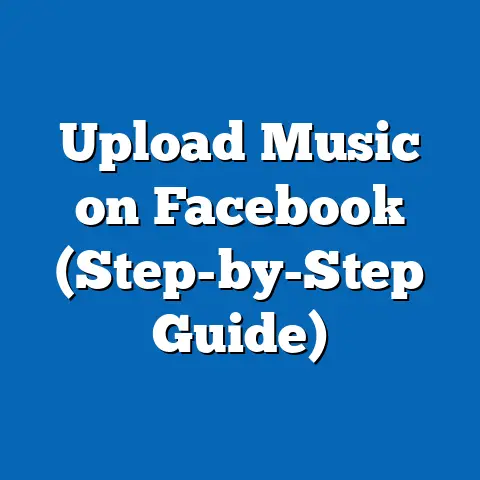Maximize Facebook Ads’ Impact (Essential Size Insights)
In the ever-evolving landscape of digital marketing, one persistent challenge stands out: how to craft Facebook advertisements that resonate across diverse generational audiences. With over 2.9 billion monthly active users as of 2023 (Statista, 2023), Facebook remains a powerhouse for advertisers, but its user base spans multiple generations, each with distinct preferences, behaviors, and technological fluency. The effectiveness of an ad often hinges on seemingly small details, such as image size, video dimensions, and format compatibility—factors that can significantly influence engagement rates across age groups.
This challenge is compounded by the fact that generational cohorts—ranging from Baby Boomers to Gen Z—interpret visual and textual content through unique cultural and historical lenses. Failing to optimize ad sizes and formats for these differences can result in wasted budgets, low click-through rates, and missed opportunities to connect with target demographics. This article delves into the critical role of ad size and format in maximizing Facebook ads’ impact, exploring how generational characteristics, historical context, and societal trends shape user responses to digital content.
We will analyze key defining characteristics of each generation, examine the historical events and technological shifts that influence their digital behavior, and provide actionable insights on ad size optimization. By understanding these nuances, marketers can craft campaigns that not only capture attention but also drive meaningful engagement across diverse audiences. The societal implications of effective generational targeting are profound, influencing consumer behavior, brand loyalty, and even broader cultural narratives in the digital age.
Section 1: Understanding Generational Cohorts and Digital Behavior
Defining Generational Cohorts
Generational studies typically categorize populations into cohorts based on birth years, shared historical experiences, and cultural touchpoints. While definitions can vary slightly depending on the source, the most widely accepted ranges are as follows (Pew Research Center, 2020): – Baby Boomers: Born 1946–1964, shaped by post-World War II prosperity and the civil rights movement. – Generation X: Born 1965–1980, often characterized as independent, having grown up during economic shifts and the rise of personal computing. – Millennials (Gen Y): Born 1981–1996, digital natives who came of age during the internet boom and the 2008 financial crisis. – Generation Z: Born 1997–2012, true digital natives immersed in social media and mobile technology from a young age.
Each cohort brings a unique perspective to how they interact with digital platforms like Facebook. These differences are not merely anecdotal but are rooted in data: for instance, while 70% of Baby Boomers use Facebook, they are more likely to engage with long-form content and static images, whereas Gen Z users, who make up 27% of the platform’s user base, prioritize short, dynamic videos (Hootsuite, 2023).
Historical Context Shaping Digital Preferences
The historical context in which each generation came of age plays a pivotal role in their digital behavior. Baby Boomers, for example, grew up in an era of traditional media—television, radio, and print advertisements dominated their formative years. Their transition to digital platforms like Facebook often prioritizes familiarity, which translates to a preference for clear, readable text and larger visuals that mimic print layouts.
Generation X, often dubbed the “latchkey generation,” experienced the advent of personal computers and early internet access. They are adaptable to technology but value efficiency, often responding well to concise ads with clear calls-to-action (CTAs) that fit seamlessly into desktop or mobile feeds. Millennials, shaped by the rapid expansion of the internet and social media, are accustomed to multitasking across devices, making responsive ad sizes and cross-platform compatibility critical for engagement.
Gen Z, having grown up with smartphones and apps like Instagram and TikTok, has a shorter attention span—often less than 8 seconds, according to a 2022 study by Microsoft. Their preference for vertical videos and immersive formats like Stories reflects their mobile-first mindset. Understanding these historical influences is crucial for tailoring ad dimensions and formats to meet generational expectations.
Societal Implications of Generational Digital Engagement
The way generations engage with digital ads has far-reaching societal implications. For instance, effective targeting of Baby Boomers can influence their purchasing decisions in sectors like healthcare and retirement services, which collectively account for billions in annual spending (Nielsen, 2022). Conversely, capturing Gen Z’s attention can shape trends in fashion, technology, and entertainment, as they are often early adopters and cultural influencers.
Moreover, generational engagement on platforms like Facebook can reinforce or challenge societal norms. Ads that resonate with Millennials’ values of sustainability and social justice, for example, can amplify movements for corporate responsibility. However, missteps in ad design—such as using formats that alienate certain age groups—can perpetuate digital divides, limiting access to information or opportunities for less tech-savvy cohorts.
Section 2: The Role of Ad Size and Format in Engagement
Why Size Matters in Digital Advertising
Facebook offers a variety of ad formats—carousel, single image, video, Stories, and more—each with recommended dimensions that impact visibility and performance. According to Facebook’s own data (Meta Business Help Center, 2023), ads that adhere to optimal sizes and aspect ratios (e.g., 1.91:1 for landscape images or 9:16 for Stories) achieve up to 30% higher engagement rates. This is because properly sized ads display correctly across devices, avoiding cropping or pixelation that can deter users.
For generational targeting, size and format are even more critical. Baby Boomers, who often access Facebook via desktop or larger tablet screens, may struggle with small text or overly busy visuals in mobile-first formats. Gen Z, on the other hand, consumes content almost exclusively on smartphones, favoring vertical formats that maximize screen real estate.
Generational Preferences for Ad Formats
Research highlights distinct generational preferences for ad formats, which directly tie to optimal sizing. A 2023 survey by Sprout Social found that 65% of Baby Boomers prefer single-image ads with clear messaging, ideally sized at 1200 x 628 pixels for desktop visibility. Generation X shows a balanced preference for both image and video ads, with a slight lean toward carousel formats (1080 x 1080 pixels) that allow storytelling through multiple frames.
Millennials, who value authenticity, respond well to video ads—particularly short-form content under 30 seconds—sized at 1080 x 1920 pixels for mobile feeds. Gen Z, predictably, gravitates toward Stories and Reels, with 9:16 vertical videos driving 40% more engagement than traditional formats among this cohort (Hootsuite, 2023). These preferences underscore the need for marketers to prioritize platform-specific dimensions tailored to each generation’s viewing habits.
Technical Considerations for Cross-Generational Appeal
Beyond generational preferences, technical factors like load times and device compatibility influence ad performance. For instance, oversized images or videos can slow down load times, disproportionately affecting older users with slower internet connections or outdated devices. Conversely, under-optimized assets may appear low-quality on high-resolution screens favored by younger users.
Facebook’s algorithm also prioritizes ads that align with its recommended specifications, meaning non-compliant sizes may receive lower reach. Marketers must balance creativity with technical precision, ensuring ads are visually compelling while adhering to guidelines like a 20% text-to-image ratio for static posts (Meta, 2023).
Section 3: Economic and Cultural Factors Influencing Ad Response
Economic Contexts Across Generations
Economic conditions during formative years shape how generations perceive and respond to advertising. Baby Boomers, who experienced post-war economic growth, often associate ads with aspirational lifestyles, responding to polished visuals that evoke stability. However, their fixed or retirement incomes may make them more price-sensitive, necessitating clear value propositions in ad copy, supported by legible formats.
Generation X, having navigated recessions and job market instability in the 1980s and 1990s, values practicality. Ads sized for quick scanning—such as square images (1080 x 1080 pixels) with minimal text—align with their no-nonsense approach to consumption. Millennials, burdened by student debt and the 2008 financial crisis, prioritize authenticity and peer reviews, often engaging with user-generated content or influencer-driven ads in video formats.
Gen Z, entering adulthood amid economic uncertainty and the gig economy, seeks value and entertainment. Their preference for ephemeral content like Stories reflects a desire for immediacy, with 9:16 formats offering a full-screen experience that captures their fleeting attention. Economic realities thus inform not just content but also the visual delivery of ads.
Cultural Shifts and Visual Storytelling
Cultural trends also play a significant role in generational responses to ad sizes. Baby Boomers, influenced by traditional gender roles and family-centric values of the mid-20th century, often respond to nostalgic imagery in larger, static formats that allow for emotional resonance. Generation X, shaped by the rise of MTV and pop culture, appreciates ads with a blend of humor and relatability, often in multi-image carousels that tell a story.
Millennials, who came of age during the social media explosion, value inclusivity and diversity in advertising. Video ads that showcase real people and real stories—optimized for mobile at 1080 x 1920 pixels—tend to perform best with this group. Gen Z, immersed in a hyper-connected, meme-driven culture, prioritizes bold, fast-paced visuals in vertical formats that align with platforms like TikTok and Instagram.
These cultural lenses highlight the importance of aligning ad size with content tone. A mismatched format—such as a Gen Z-targeted meme in a desktop-heavy landscape format—can disrupt the intended cultural connection, reducing engagement.
Section 4: Societal and Workplace Implications of Optimized Ads
Shaping Consumer Behavior and Brand Loyalty
Effective ad sizing and generational targeting have profound implications for consumer behavior. For Baby Boomers, well-optimized ads can build trust in brands, particularly in industries like healthcare, where trust is paramount. A 2022 Nielsen report found that 58% of Boomers are more likely to purchase from brands with clear, accessible digital ads.
For younger generations, optimized ads can drive viral trends and brand advocacy. Gen Z, for instance, often shares engaging content with peers, amplifying reach organically—especially for ads in Stories or Reels formats. Millennials, as a bridge between older and younger cohorts, influence both upward and downward, making their engagement critical for multi-generational campaigns.
Brand loyalty also hinges on consistent digital experiences. Ads that fail to load properly or appear distorted due to incorrect sizing can erode trust, particularly among tech-savvy Gen Z users who expect seamless interactions. Conversely, tailored formats can enhance perceptions of a brand’s relevance and attentiveness.
Workplace Dynamics and Marketing Strategies
In the workplace, generational insights inform not just consumer targeting but also internal marketing strategies. Companies with multi-generational workforces must communicate effectively across age groups, using platforms like Facebook for internal campaigns or employee engagement. For instance, HR ads promoting benefits might use larger, static formats for Boomer employees while leveraging video Stories for Gen Z hires.
Moreover, understanding generational ad preferences equips marketing teams to allocate budgets efficiently. A 2023 study by eMarketer revealed that campaigns with format-specific optimizations achieve a 25% higher return on ad spend (ROAS). This data-driven approach fosters collaboration between creative and analytical teams, bridging generational divides within organizations.
Broader Societal Impact
On a societal level, optimized Facebook ads can either bridge or widen digital divides. Accessible formats for older generations ensure they are not excluded from critical information, such as public health campaigns or financial services. Conversely, overemphasis on mobile-first, vertical formats risks alienating users with limited access to cutting-edge technology, perpetuating inequities.
Additionally, generational ad targeting influences cultural narratives. Ads that resonate with Millennials’ and Gen Z’s values—such as sustainability or social equity—can drive public discourse, as seen in campaigns like Nike’s inclusive marketing initiatives. However, marketers must avoid tokenism or pandering, ensuring authenticity in both content and delivery format.
Section 5: Practical Strategies for Maximizing Ad Impact
Tailoring Ad Sizes by Generation
To maximize impact, marketers should adopt a segmented approach to ad sizing: – Baby Boomers: Prioritize desktop-friendly formats like single images (1200 x 628 pixels) with large, readable text. Avoid overly dynamic content that may overwhelm less tech-savvy users. – Generation X: Use versatile formats like carousels (1080 x 1080 pixels) that work across devices, focusing on clear CTAs and efficient messaging. – Millennials: Leverage mobile-optimized video ads (1080 x 1920 pixels) under 30 seconds, emphasizing storytelling and authenticity. – Generation Z: Focus on vertical formats like Stories and Reels (9:16 ratio), incorporating bold visuals and interactive elements like polls or swipe-ups.
Testing and iteration are key. A/B testing different sizes and formats can reveal nuanced preferences within generational cohorts, as not all individuals conform to broad trends.
Leveraging Analytics for Optimization
Facebook’s Ad Manager provides robust analytics to track performance by demographic. Metrics like click-through rate (CTR), engagement rate, and cost-per-click (CPC) can indicate whether an ad’s size and format resonate with the intended audience. For instance, a low CTR among Baby Boomers may signal the need for larger visuals or simplified designs.
Marketers should also monitor device-specific data, as generational cohorts often favor different platforms (desktop for Boomers, mobile for Gen Z). Adjusting ad dimensions based on these insights ensures maximum visibility and minimizes wasted impressions.
Balancing Creativity with Compliance
While creativity drives engagement, compliance with Facebook’s guidelines is non-negotiable. Ads with excessive text or incorrect aspect ratios risk reduced reach or outright rejection. Tools like Canva or Adobe Spark offer templates aligned with Meta’s specifications, streamlining the design process for busy marketers.
Additionally, accessibility features—such as alt text for images and captions for videos—enhance inclusivity across generations. These elements ensure that ads are not only visually optimized but also usable for individuals with disabilities, a consideration that resonates particularly with older cohorts.
Section 6: Forward-Looking Insights and Uncertainties
Emerging Trends in Digital Advertising
As technology evolves, so too will generational preferences for ad formats. The rise of augmented reality (AR) and virtual reality (VR) could redefine engagement, particularly for Gen Z, who are eager adopters of immersive experiences. Facebook’s investment in the Metaverse suggests that 3D or interactive ad formats may soon dominate, requiring new considerations for size and compatibility.
Artificial intelligence (AI) also promises to revolutionize ad optimization. AI-driven tools can analyze user behavior in real-time, dynamically adjusting ad sizes and formats for maximum impact. While this offers exciting potential, it raises questions about privacy and data ethics—concerns that resonate differently across generations, with Millennials and Gen Z often more vocal about transparency.
Uncertainties in Generational Dynamics
Despite the wealth of data, uncertainties remain. Generational boundaries are not rigid; individuals may exhibit behaviors outside their cohort due to personal circumstances or cultural influences. Moreover, the rapid pace of technological change means that today’s optimal sizes may become obsolete as new devices and platforms emerge.
Economic and societal shifts—such as inflation, climate crises, or geopolitical events—could also alter generational priorities, influencing how they respond to ads. Marketers must remain agile, continuously updating strategies to reflect these evolving dynamics.
The Path Forward
Looking ahead, the key to maximizing Facebook ads’ impact lies in a blend of data-driven precision and empathetic storytelling. By understanding generational nuances and prioritizing ad size optimization, brands can forge deeper connections with diverse audiences. The societal stakes are high: effective digital advertising can shape consumer behavior, influence cultural trends, and bridge generational divides—or exacerbate them if mishandled.
As we navigate this complex landscape, ongoing research and adaptability will be essential. The digital realm is a shared space, and crafting ads that resonate across generations is not just a marketing challenge but a societal imperative. By embracing the insights outlined in this article, marketers can turn the challenge of generational diversity into an opportunity for meaningful impact.

